Blackout (2023)
We’re a damaged species and it’s funner to talk about it with a monster story, Larry Fessenden said after the March 13 NYC premiere of his latest creature feature.¹ In the spirit of Lon Chaney Jr.'s benighted Larry Talbot, Blackout gives us the monster's dilemma: suicide or homicide?² This telling of the werewolf story takes us to a small, upstate town in post-2016 crisis (Talbot Falls, y’all!), where the personal relationships that form community break down under self-inflicted economic pressures³ and the monstering of outsiders. Bring in low-wage laborers for divisive development projects, isolate and treat those workers like shit, then blame them for the mangled bodies turning up every full moon. "You got the haunt in you, can I help?" Miguel, unoffocial spokesperson for the workers and target of old racist developer Hammond says to Charley, who wears trouble like a 3-day flannel. Charley's too focused on Miguel's unfinished beer, after chugging his own, to see that he's been seen. Miguel is too compassionate, and too world-weary, to say what he also knows: everyone, especially the laborers, will pay the monster's tab, and Charley's remorseful daytime lone wolf activism won't change that particular economy. Woof. 5 out of 5 sacs of blood.
Note: The IFC premiere featured a balcony gallery of materials related to the film, including posters, photos, and some of the paintings John Mitchell made for the film. (Snarly Charley is a painter, and his loose grip on reality is conveyed by full-screen insertions of his increasingly distorted figurative paintings in place of diegetic scenery or action.) Below are some bad photos of highlights from that collection, and a snap of my turn on the red carpet.
¹ Earlier that evening, before night fell, I wandered down 6th Ave on my way to grab a bite at Spicy Moon, and glanced at the IFC marquee out of habit, turning into a cartoon rabbit with eyeballs telescoping at the words BLACKOUT: Q&A WED\THURS. Wait, today is Wednesday! Turns out they had one (1) ticket left, and it was all mine. When I returned from tooling around during the situationist holiday in the hours before showtime, what I thought was a queue for the premiere turned out to be a miniature red carpet. Alas, I was captured.
² I asked Fessenden about this motif, and how he developed his take on the werewolf story. He pointed out that most of the violence in the film is done by people in town, and the monster mostly makes chaos. He also said he couldn’t say it’s a film about suicide as he developed it, but it is a suicide film.
³ To be sure, external economic pressures on small rural towns are real, and in this case we see those pressures being exacerbated by local citizens exploiting their own communities.
—J †Johnson















